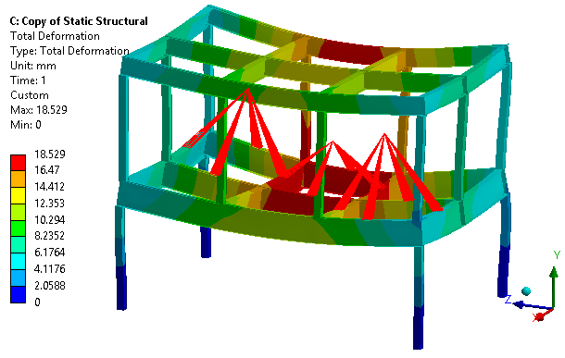Structural analysis is the process of determination of effects of load and calculating internal forces on physical structure and their components. It is mainly used to check the structural integrity to withstand the loads of the structures and their impact on engineering design. Structural analysis obeys the set of standards and physical law such as applied mathematics, material science and applied mechanics to calculate the structure deformation, reactions, stresses, acceleration, etc. It allows engineers or designers to ensure structure or their components are safe for use under the estimated loads as expected to withstand.
Structural analysis thus is very important of engineering design of structure and primarily used in civil engineering which includes buildings, bridges: and in aerospace & offshore engineering which includes aircraft frames, ships & topside module: and in mechanical engineering for pressure vessel, tanks and reactors, etc.; as well as for non-building structures from other engineering branch work.
Loads on Structure:
There are mainly two types of load, the first one is dead load which consist the weight of whole structure including attached parts. For examples, building dead load mainly consist weight due to columns, beams, floors slab, walls, roofs, girders and attached parts like, plumbing, electric fixtures and other miscellaneous parts, etc. The second type of load is live load which is not constant but vary due to in magnitude and movement of the object (people, vehicle, etc.), for example, highway bridge loads, railroad bridge loads, impact loads, there few more environmental loads which comes under live load category like snow loads, earthquake load, wind loads and other natural loads, etc. Once dimensional requirement are defined, the loads coming on structure are identified then it is necessary to determine the loads structure can withstand. There are mainly two building codes are available which provides the design loading for structure. The first one is general building code and second one is design codes, the structural engineers must satisfy these code requirements for to
Structure Classification:
A structural system consist not only its structural elements but also their connecting parts, materials, etc. It includes various elements like truss, beam or column, walls, stiffeners, an arch, connecting rod and frame, etc. All these individual elements are undergone the loads (forces) during structural analysis and results are seen for all these elements. It is important for structural engineer to study the behavior of the structure and its elements under the applied structural loads.
Types of Structural Analysis Methods:
The decision on structure is safe or not is taken based on the analysis results. The typical analysis results includes support reaction, stresses and deformation which are then compared with the assessment (failure) criteria. Structure is said to be safe if analysis results meets the criteria. There are mainly three methods of structural analysis. The first two methods are suitable for linear elastic models uses closed form solution and solved by analytical formulations also called as hand calculation methods.
The Mechanics of Materials Method (Strength of Materials):
This is simplest method suitable for simple structure for specific loading like circular shaft subjected to torsion, bars with axial loads, pure bending scenario, etc. The entire structure like truss can be analyzed with this methods in combination with method of sections & method of joints for truss analysis, moment distribution & cantilever method for small and large rigid frame. In this method, the solutions are based on linear isotropic infinitesimal elasticity Euler–Bernoulli beam theory. If you are looking structural analysis for more complex structure then you will either need to refer FEA method or other civil structure software’s, etc.
Elasticity Theory Method:
In this method, the solution is derived from equations of linear elasticity. It uses elasticity equations like partial differential equation. It is suitable for simple geometries and useful for individual members such as column, beams shafts, shells, plates and stiffeners, etc. for complex geometric, FEA method is necessary.
Finite Element Analysis Method:
It is most commonly used numerical method for structural analysis. Here the continuous system of structural member like plate or shells are modelled using discrete system with finite number of element (meshing) interconnected at finite number of points (nodes) and the entire structure stiffness is the calculated based on addition of the stiffness of the each and every elements. It is based on matrix algebra to solve systems of simultaneous equations, partial differential equations and hence it is also called as matrix methods of structural analysis. It is computer based tool which has been developed and used long before for simulating and analyzing engineering products and systems. In this method, software codes uses various mathematical equation (stiffness, force and displacement matrix formulation) to predict the behavior of each elements. Furthermore, computational methods and various failure theories are used to combine the responses, which is used to predict the overall behavior of the analyzed part. It provides results like reaction (forces and moments), displacement, and stresses on each member of the structure. And hence it is more suitable for complex structure analysis which involves various load events, such as offshore structure subjected to wave & current loading, topside module structure subjected to dead, live and wind loads, etc. Figure 1 shows the simplified topside module total deformation plot. This topside module is mounted on FPSO, which are subjected to various load events such as wind load & dead load, etc. The structural analysis for topside module will produce results in the form of stresses, deformation and reactions on each structural member and their respective joints (Present results for the critical joints within the structure). Thus FEA method is very useful method to find the behavior of structure for various load events.

